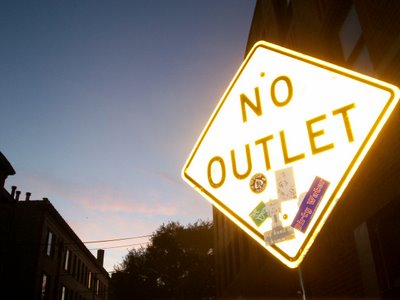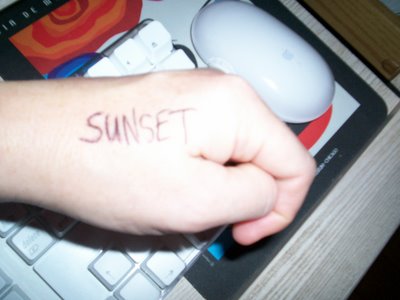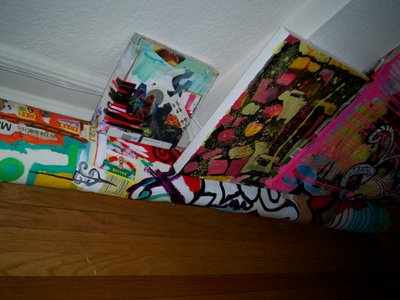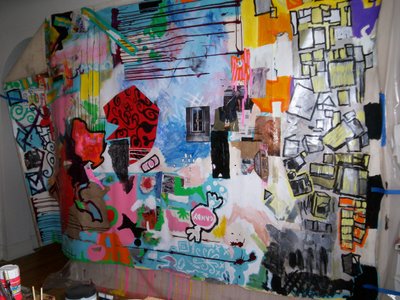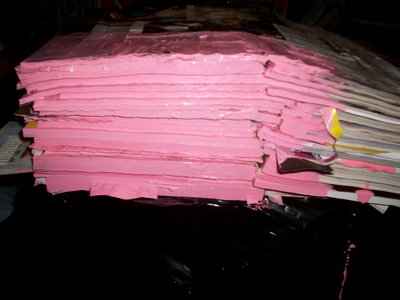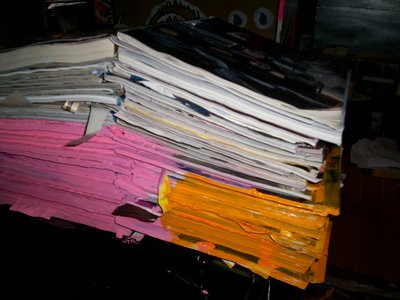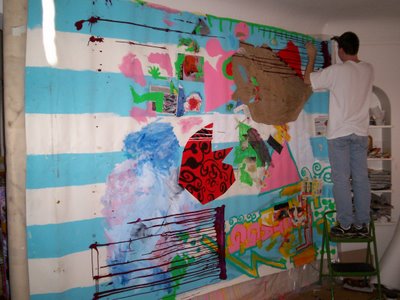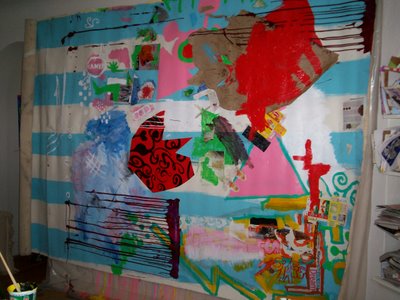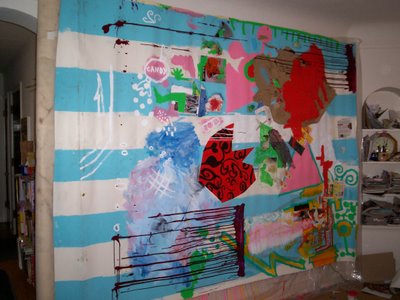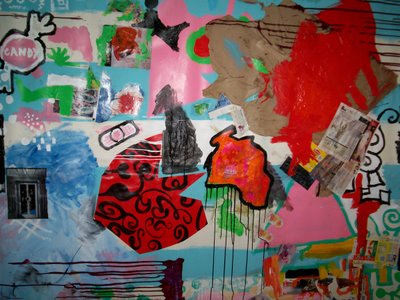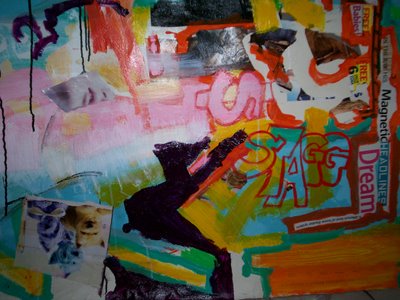During the Warhol/Supernova exhibit in Toronto this summer an alternative press published a whistleblower-style blurb about a curator in a major public and private funded gallery in Canada. I became interested in this article because I couldn't find any coverage of the allegations in the Canadian mainstream media.
Frank Magazine reported that David Moos told gallery volunteers not to mention a neighbouring exhibit of Warhol to patrons, a move that may breach the
mandate of the Art Gallery of Ontario.
The mandate of the Art Gallery of Ontario (AGO) is to: cultivate and advance the cause of the visual arts in Ontario; offer education and other programs on the origin, development, appreciation and techniques of the visual arts; collect and exhibit art and displays; maintain and operate the gallery and its facilities; and stimulate public interest in the work of the gallery. Usually the Canadian mainstream media may cover art scene activities on it's back pages, a revealing practice on the status of art in Canada, but considering that taxpayers employ staff at the AGO overlooking these allegations inspired me to request an interview with David Moos.
I was very pleased and impressed that David Moos agreed to an interview, which we conducted through two primary e-mails. I sent my set of questions to the Public Relations department at the AGO, and the Public Relations department returned his responses. I have only read through this entire interview once at the time of this post so that I may reflect and consider comments and my own responses with other bloggers. In my initial response to David's responses I found several traditional themes and a few surprises in his responses. Although the traditional role of a curator is to preserve artifacts I was surprised that the artists he referenced did not include underground, alternative or lowbrow artists. And I was surprised he would consider accepting a donation of a Damien Hirst work to the Art Gallery of Ontario. Damien Hirst has killed an animal to restore an art work, not only did Hirst taking the life of an animal for art oppose my personal ethics,
Canadian law agrees with me.
I look forward to reflecting on this interview and hope other artists and art lovers find some value in the exchange. I intend to respond further to some ideas in this simple experimental interview in the comments area. I think David Moos was a very good sport to participate because I asked him some unusual questions.
Candy: Thank you for sharing your time by doing an online interview with me David. I am really excited for this opportunity for a view into the life of a curator in Canada. I realize this is a huge dedication of your time from a busy schedule with your work load and family life, and I really really appreciate your sense of adventure to participate with me.
David: I am pleased to have a dialogue with you and try to address your thoughtful questions. Here are some answers or responses to some of your questions.
Candy: I loved the Warhol/Supernova show at the Art Gallery of Ontario this summer. I was lucky enough to see both the Chicago setting and the Toronto setting of this awesome perspective on Warhol's legacy. If I hadn't been invited to the "artist's evening", a regular event at the AGO, I might not have seen the Toronto exhibit. I couldn't afford the $18.00 charge for the show. In Chicago, the exhibit was only $10.00. I can't imagine how many families could afford $40.00 to enjoy this Warhol experience, especially considering it is their tax dollars that pay for the AGO's operation. How much do you think is too much for the public to pay to see a show at the AGO?
David: In terms of the admission price of “Andy Warhol/Supernova,” I think each museum has to reach its own conclusions about the exhibition experiences it is offering. If you are to compare the Chicago presentation with the Toronto version of this exhibition (that was actually conceived by Douglas Fogle at the Walker Art Center in Minneapolis), then I think you are comparing two very different exhibition experiences. Only in Toronto do viewers have the David Cronenberg guest-curated experience, and Cronenberg substantially impacted the presentation of the exhibition. A crucial aspect of the AGO exhibition experience is the audio guide, or what we refer to as the “soundtrack” to the exhibition. Viewers are strongly encouraged to take the audio wand and let Cronenberg play exhibition guide because he is so insightful and creative, and because his conversions with other Warhol luminaries brings the material to life in ways not palpable in Chicago or Minneapolis. Also—and this is important not just for the exhibition’s visual complexion, but for Warhol studies in general—Cronenberg (in collaboration with me) developed the notion of screening Warhol films adjacent to the paintings within the exhibition proper. To have painting and film-making sharing the same wall and the same visual space is a breakthrough. Warhol may have done it in 1968 at his Moderna Museet exhibition in Stockholm (what didn’t Warhol do?), but this is the first time in recent years that this dual-medium presentation has occurred, and it has far reaching implications, offering up a new way to comprehend what Warhol was achieving in those staggeringly creative early years of 1962-1964. Also, because Cronenberg wanted to emphasize the darker side of Warhol’s imagination, we expanded the selection of disaster paintings, adding such landmark works as “Red Disaster,” “Foot and Tire,” “1947-White” (the only suicide painting in “Supernova” in any of the three cities), and, perhaps the ultimate car crash painting “White Burning Car.” Coupled with the augmented “Jackie” material and a few other additions, the Toronto exhibition is quite a powerful presentation. Is all that original content worth $18.00? I suppose the audience decides and the success of the exhibition so far is some indication that there is a balanced value for dollar proposition installed in “Supernova.”
Candy: I was in Nashville a year ago looking at art. The Fisk University has a huge collection of art donated by Georgia O'Keefe from her husband's estate. I was in a hotel across the street from another gallery,The Frist, and they couldn't tell me anything about the Fisk University collection. We had to google the topics to find out about the Fisk's Alfred Stieglitz collection. We were dumbfounded and made complaints to the Frist museum. When we tracked down the gallery at Fisk, not only was it an outstanding collection, their gallery had literature about the city's art scene including the Frist. The lack of cross promotion of an art scene was depressing to us and indicated a lack of enthusiasm, pride and professionalism to me in a large operation like the Frist.( I have noticed since our visit The Frist have added links to the Fisk and other galleries on their website. PROPS!) Imagine my surprise to find that a similar stagnant cross promotion was occuring in a public Canadian gallery? There were two Warhol shows in Toronto this summer and it was as if the AGO didn't know the Oakville exhibit existed. Do you think this is the way to lead a progressive contemporary art scene in this country?
David: I agree with you that collaboration is the key to success. We met with the Oakville Gallery staff prior to our Warhol exhibitions opening and brainstormed collaborative possibilities regarding cross-promotion. We included each other’s exhibition material in our press kits and we did a brochure swap so that each institution had information available about the other’s exhibition. We were generally pleased with the joint promotion.
In terms of collaborative ventures, I and my colleagues in the contemporary art department (and I may surmise, across the AGO), are involved in many collaborative projects. For example, this summer I co-curated, along with Kitty Scott of the National Gallery of Canada and Stephane Aquin of the Montreal Museum of Fine Arts the exhibition “Sound + Vision: Contemporary Photographic and Video Images in Contemporary Canadian Art,” a major summer exhibition at the MMFA that was on view until October 22nd. The exhibition was drawn from the three museum collections and serves as a context within which the work by emerging Canadian artists can be seen against the contributions of older, iconic Canadians. The MMFA produced a thin publication with a trialogue by the three curators, which I could send to you if you like. This example of a close collaboration is the kind that I favour, as all participants have an equally engaged voice and stake in the project from start to finish.
In recent months I have been in contact with colleagues at other Toronto institutions (such as Kelvin Brown, Director of the Institute for Contemporary Culture at the ROM), in order to propose collaborative projects. The fate of our shared ambitions remains to be seen, but our dialogue is strong. I note a similar level of open communication with the Power Plant (Director Greg Burke serves on my department’s Contemporary Curatorial Committee). Given these examples, I don’t think the Nashville paradigm bears much resemblance to the AGO’s position in the contemporary art community. And, I am not even mentioning the various advisory boards and committees that me and assistant curators Michelle Jacques and Ben Portis have vital engagement with as participants and/or leaders.
Candy: What Canadian curators work do you admire, and for what reasons?
David:
Stephane Aquin, Curator of Contemporary Art Montreal Museum of Arts.
Daina Augaitis, Bruce Grenville, and Grant Arnold at the Vancouver Art Gallery
Why?
Solid work: compelling and timely exhibitions accompanied by serious essays in substantial publications
Also, I appreciate Andrew Hunter, a curator who has worked at numerous Canadian institutions, for he is always patrolling the fringe of creative possibility in curating and creating innovative projects.
Can I ask myself an elaborated version of your question…?
Michael Auping, Modern Art Museum of Fort Worth
Gary Garrels, Hammer Museum, Los Angeles
Madeleine Grynsztejn, San Francisco Museum of Modern Art
Candy: What Canadian contemporary art holds your passion and why?
David: So much Canadian art holds my passion for a variety of reasons. I’ll name some artists who I think are producing important work that will continue to shape the discourse around visual culture both within Canada and internationally.
Tim Lee from Vancouver is intense, brilliant, witty, profound and his work speaks to the heart of what it means to be Canadian in the early 21st century.
Kent Monkman is one of the ultimate painters at work and he has managed to make postmodernism seem once again profound. His perfectly painted new narratives of North American landscape painting recode the world according to an aboriginal point of view. And he accomplishes this on a grand scale that transports the viewer back in time to a space of other possibility.
Iris Haussler has created one of the more beguiling environments I have encountered anywhere in the artworld, in an unassuming house on an unassuming street in Toronto. If you have not been to
105 Robinson, I urge you to take the tour and encounter the recently discovered private world of Joseph Wagenbach, which is a truly mind-expanding experience. Her total-environment can certainly be considered in relation to efforts by internationally celebrated artists such as
Gregor Schneider or the recently deceased
Jason Rhoades. I also especially admire the work of
Francoise Sullivan, an artist who in typical Canadian fashion, has created a body of work over the span of a lifetime but has received only modest acclaim. Her multifaceted oeuvre is staggeringly groundbreaking. For example, she pioneered the genre of performance in contemporary art. Her achievement would be more widely celebrated if Canada realized how valuable the work of such artists is in a broad cultural context. Sullivan’s diverse work that commences in the late-1940s deserves to be critically appraised and celebrated. The list of worthy names is enormous, but these four artists offer a glimpse of my thinking today.
Candy: My first art course at university was with
Mowry Baden. During the first week of classes he counted us. He said, "Out of the two dozen here today, half at most will still be practicing art in five years. In ten years only three of you will still be practiicng art." I remember laughing and thinking, I'll still be here, and that must be what the cliche "struggling artist " means. Young as I was, I didn't realize that most people who pay for education do not land up in the profession they studied, but art surely seems to have the biggest odds against it. What role do you feel the AGO, and you as a curator, does or should play in the support of unknown and struggling artists?
David: How can the AGO support unknown artists… by being the most accessible and inspirational resource imaginable, and by functioning as a platform to promote their efforts. The AGO aspires to become a place where ideas can be exchanged and creative conversations staged. Generating a discourse and providing a framework within which new ideas and creative ambitions can be nurtured is a crucial ambition of the AGO. And not only should young artists feel embraced and inspired at the AGO—but creative minds from all disciplines should become engaged (designers, illustrators, musicians, ventriloquists, et. .al.)
Candy: A couple things disturbed me while reading an article in Frank magazine. Frank magazine's Loose Lips column said "(Moos) consistent advice to patrons and collectors that buying Canadian art is a bad investment has done little to endear him with our homegrown wards of the Canada Council." How do you reconcile working for a Canadian funded art gallery with this advice?
David: Did I say that Canadian art is a bad investment? No.
Does Canadian art offer opportunistic collectors intent on making money through the acquisition and re-sale of artworks the same kinds of rewards available in international contemporary art? No.
The value and depth of the international art world has geometrically expanded in the last decade. Witness the rise of the art fair as main trading floor of the art market—from Basel, Switzerland to Basel, Miami, from New York’s Armory Show to London’s Frieze. Witness the boom in New York Gallery real estate, where super-galleries such as Gagosian (another additional giant new space opened on Oct. 25 with an Andy Warhol exhibition), David Zwirner (recently opened two new galleries on either side of his existing gallery), Pace Gallery, Matthew Marks, Marian Goodman, et. al. Many of the artists exhibiting in these galleries command prices that can only be sustained through the vast internationalization of the art world. Witness the role that the mega-private collector now plays in setting taste, manifesting curatorial opinions and asserting the value of certain artists. Witness the role that auction houses now play in assessing the value and currency of emerging artists.
Realize that the art world has changed. The stakes are so much higher and most cultured individuals have realized this, as have most cities that are heavily investing in their culture sectors (Toronto being a great example of this consciousness).
The Canadian art market is smaller in scale than international markets. Think of the staggering prices realized by young British artists such as Damien Hirst,
Chris Ofili,
Sam Taylor-Wood, to pluck three diverse artists from the panoply of expensive young talent. To my knowledge, no Canadian painter commands about $1 million per painting, the way Ofili does. (Peter Doig is the one exception, and his market was made outside Canada).
From the point of view of playing the art market in the manner that one plays a stock market, my advice would be to trade internationally. Is this something I advocate? No. Would the AGO be interested in acquiring (most probably the only way to do so would be through donation) a Chris Ofili painting, or a sculpture by Damien Hirst, or a major work by Sam Taylor-Wood? Yes. And yes, the Doig would be great as well.
Candy:
James Surowiecki, in The New Yorker, said " In the end, the more people come to think that art is a good investment, the quicker it will become a bad one." Why is it a good practice for a curator to discuss investment when according to some estimates less than one percent of all art purchased makes a profit in resale?
David: For the curator of a major collecting institution not to be aware of the art market is…simply not possible.
Candy: I am sick of going to galleries and seeing what I call "oneliner art" or "punchline art". Most of the time I feel like I've walked into a bad Vegas lounge act. Ba dum bump. Outside a Chicago public museum right now there is a car coming out of the ground pulling a trailer. Ba dum bump. An artist funded by millions of Pounds dropped a bunch of ping pong balls down a flight of stairs in Britain. Ba dum bump. I can give you many of examples, over twenty or thirty years. I believe that treating art like it's purpose in culture is for investment has partly contributed to this desperate attempt to entertain the few people who go to galleries. To the majority of the public art has become...a joke. Art programs suffer and for regular people they see artists and curators as a waste of money, and worse, time. What do the words ART GALLERY OF ONTARIO mean to you in 2006?
David: I don’t think you will find much “punchline art” in the contemporary program at the AGO. But you may find art that defines the difference between easy art and truly challenging new art. By the way, did you see the
Tino Sehgal work installed this past summer at the AGO?
The meaning to me of “Art Gallery of Ontario.”
We Bring Art and People Together and boldly declare Art Matters.
Candy: Which 5 works would you acquire for the AGO if money were no option?
David: The needs and dreams are many, but with the exception of Eva Hesse, I will list painters and stay only in the 50s and 60s:
Any of the following would be fine with me…and all would need to be major works:
Jackson Pollock
Barnett Newman
Clyfford Still
Philip Guston
Joan Mitchell
Cy Twombly
Yves Klein
Yayoi Kusama
Francis Bacon
Lucien Freud
Jasper Johns
Roy Lcihtenstein
Helen Frankenthaler
Edward Ruscha
Eva Hesse
Jean-Michel Basquiat
Candy: What work do you have hanging in your bedroom?
David: John Wesley, “Second Honeymood,” 1993, acrylic on paper, 22 x 30 inches
Candy: What was the last work (painting, sculpture, etc) you purchased, personally?
David: Julianne Swartz, “Periphiscope,” 2003, electric conduit, lens, mirror, wire, plastic, clock, motor, mylar, light
Dimensions variable
Candy: What percentage of your income do you spend on the purchase of works by living Canadian artists?
David: I haven’t bought a work of art since moving to Toronto two and half years ago, because I have been more focused on collecting books. I feel that collecting for myself, while endeavoring to groom and grow the nation’s premier collection of contemporary art, may cloud my judgment and give rise to conflict of interest. I prefer to think 100% AGO collecting thoughts, rather than dabble with my own personal ambitions.
Candy: Are you, personally, an affiliate member of CARFAC?
David: No, not a member.
CAA Only a member in years when I attend the annual meeting in order to present a paper (once about every 3-5 years).
Candy: In a curator's day/ year/ etc. - to whom do you feel most open to criticism by, and why?
David: By the public, whether I respond to an email by an interested museum visitor who is a regular citizen, or I read a review in a local newspaper or magazine. Criticism… I thrive on it.
Candy:
Name 7 living Canadian artists whose work you feel is underappreciated?
David: Iain Baxter& / N.E. Thing Co., Betty Goodwin, Anitra Hamilton, Kent Monkman, Evan Penny, Michael Snow, Françoise Sullivan.
Candy: Name 7 dead Canadian artists whose work you feel is of the best there is in the world?
David: Paul Emil Borduas, Jack Bush, Emily Carr, Greg Curnoe, Gershon Iskowitz, David Milne, Jean-Paul Riopelle.
Candy: I suggest we set up a tent outside the AGO year-round and offer kids who are homeless, often unable to fit into traditional school settings, art lessons. I will find and schedule the artists to give lessons and restaurants that will cater lunches. This will be the third innovative cost savvy dynamic proposal I have made to the AGO in the past year. Would you start an art literacy program with me for street kids?
David: Why that single group in need? Are there other groups of similar need? Do I have to choose among groups? Am I most interested, right at this moment, in new Canadians, people who have literally just stepped off an airplane from a distant land? Would I invest in a program directed toward them first if I had to choose? Is money an issue in your question, or are you just fabulating? What about handicapped children, before street kids? What about children who have grown up in dire poverty before street kids? What about children with terminal diseases… Am I inclined to privilege those who have had no choice, perhaps.
Further References:
Zeke's Gallery.
Frank magazine tradition(Canada's Jon Stewart?).
Shark life for art.
Animal care in film production.
Art Gallery of Ontario funding.Canadian media magnate and AGO sponsor,
Ken Thompson.



















